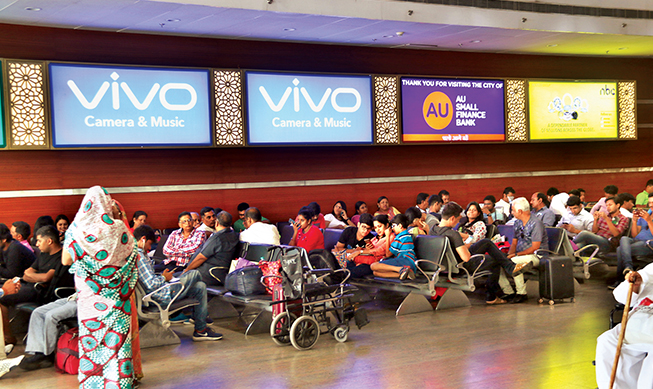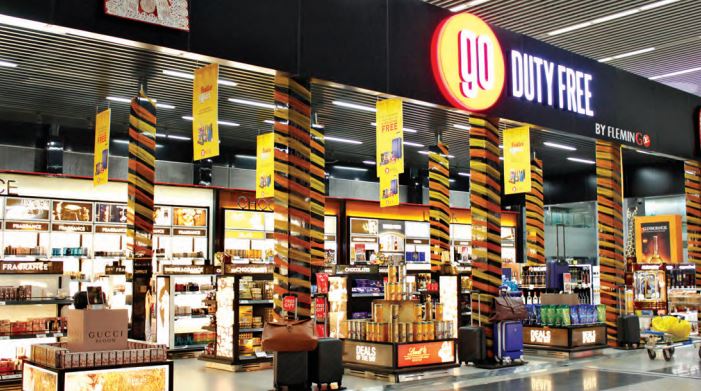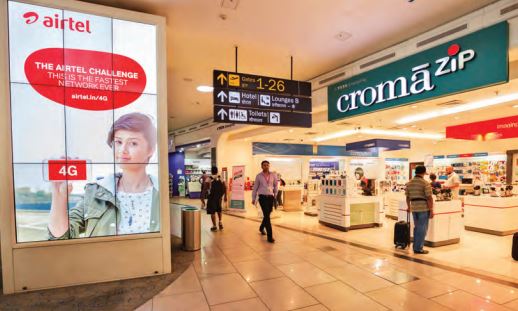How Airports Make Money in India?
AIBM
October - December 2017
The understanding of sustained financial health in the Indian aviation sector, especially at airports, still remains a challenge in India. With non-aeronautical revenue such as retail or advertising coming to rescue over the years, it is quite intriguing to appreciate how the Indian airports are surviving in a time of susceptible economic conditions.
India is currently the third largest domestic civil aviation market in the world, having recorded a total of 100 million domestic flyers in 2016 according to the Centre for Asia Pacific Aviation (CAPA). The International Air Transport Association (IATA) predicts that the country will be the overall third largest aviation sector by 2026. According to IATA, India has become the world’s fastest-growing domestic travel market for the 22nd time in a row, recording a 26.6 pc year-on-year growth in January 2017. However, In 2016, the Airports Authority of India (AAI) that registered a net profit of more than INR 25 billion, only 13 of the 125 airports managed by the AAI were cost-effective. The dissection of the future forecast and the precedent records led us to an interesting study deciphering the strengths and limitations of Indian airports as independent commercially viable units. Optimising the potential of India’s growing civil aviation market, the airports in India pose a formidable chance to become profit centres in the near future, but the job is easier said than done.
As AIBM was in conversation with S Suresh, a Member of Finance, AAI regarding the various challenges in the airports business in India, a few pertinent facts opened up. Commenting on the turnaround strategy to meet the NITI Aayog target of increasing 35 pc in airport revenue, Suresh said, “Our turnaround strategy includes leveraging the full potential of seasonal traffic by putting up tourist huts and hotels. However, the facility should be re-designed so that during the lean period the facility can be shut down to minimise operating costs. Moreover, the airports that are situated inside cities can be used to generate revenue by using them as exhibition grounds and display/sales facility for consumer goods household items, cars, etc. Revenue of parking area can be increased by discouraging parking of vehicles outside authorised parking areas.”
Procuring funds for modernisation of the old aerodromes is another impending challenge for AAI. Entering into a joint venture with players in different fields, creating new facilities on a turnkey basis through global bids, offering airlines and operators same incentive to increase traffic flow at airports to make more viable commercial exploitation of existing facilities and introducing cost-cutting measures are some of the strategies, Suresh mentioned.
The Airport Marketing division of AAI has been instrumental in taking initiatives of engaging stakeholders such as airlines, ground handlers, freight forwarders, tourism agencies, industry associations, local authorities, etc. at various airport cities such as Chennai, Kolkata, Guwahati, Allahabad, Jaipur, Kullu, Shimla, etc. to identify challenges, exchange and share ideas and market dynamics for the growth of industry.
Airport Business – changing landscape
The competition in the aviation sector is gathering pace in India. With the liberalisation of business rampant in a global market; the consumer preference while choosing a product has become not only price sensitive but also service sensitive. Airports around the world are going through a mass transformation in terms of how they generate revenue. Tariq Hussain Butt, the Head of Airport Marketing, AAI shared a piece of his thought with AIBM, “The privatisation of airports started in 1987 when UK Government sold its eleven major airports including three airports (Heathrow, Gatwick and Stansted) in London area to BAA Plc (Formerly as British Airport Authority) a 100 pc private sector firm. After the evolution of airport privatisation, the concept of Airport Marketing started in the early nineties in developed economies. In India too, after the privatisation of airports, operators started developing and implementing marketing strategies to increase airline customer base, enhance passenger footfall and generate revenues.”
Describing the role of airport marketing in a time when vulnerability in the economy has to be balanced with the changing demands of the consumers, Butt said, “Airport Marketing can be described as the function by which airports interact with their target groups and identify and address each group’s needs in order to stimulate and accelerate their growth, resulting in more aviation and non-aviation revenues.”
Responding to the huge disparity in profits made by the 13 out of 125 airports handled by the AAI, Butt added, “Only few airports especially metro airports are earning significant revenues whereas airports in medium and small towns are making losses due to various reasons such as industrial & economic growth of the city, tourism potential, population with spending capacity, economic viability of airline operations, lack of marketing initiatives, etc. During preparation of Strategy Document 2010-2015 by the Ministry of Civil Aviation (MoCA), it was clearly emphasised to strengthen the marketing capabilities of AAI. Therefore, Airport Marketing Directorate was created in 2015.”
S Suresh reflecting on the present scenario of the Indian aviation business also added, “The Government of India has already launched the regional connectivity scheme (RCS) and the flow of passengers at remote locations will enable AAI to further enhance the revenue from commercial exploitation of these locations. Airports which are strategically located but have less traffic probability of sharing facilities for neighbouring states will be explored.”
Tariq Hussain Butt explained how airports in India have to commit to innovative marketing as a priority in order to attract more passengers, additional concessions, or new carriers. Speaking about the opportunity in cargo marketing, Butt said, “There is also a huge potential of export cargo (General and Perishable Cargo) especially from the cities like Ahmadabad, Kolkata, Goa, Amritsar and Chennai. Guwahati and its catchment area in North East Region have an abundant scope of export of perishable cargo, however, due to lack of infrastructure such as pack houses, refrigerator vans, cold storages, etc. lack of international connectivity, perishable cargo cannot be fully exploited.”
Airport retailing gaining momentum
As a number of chic new airports are springing up across tier 2 and tier 3 Indian cities, conventional malls are presumed to witness a stiff competition. One of the prime aspects of airport revenue system, terminal retailing in India has clearly gained momentum. In the last couple of years as the expansion and modernisation of more airports gathered pace, airports in India can now easily qualify as retailing destinations for international as well as domestic travellers – a unique hub where Indian brands can tap the global market without setting up a shop abroad.
Commenting on how the retail therapy in airports can add value to the attraction quotient of airports as well as surge the revenue, Butt said, “There are several opportunities for improvement in the financial performance of smaller airports. For instance, there can be improved development and use of retail opportunities at the airports – as witnessed in several of India’s newer airports. This could act as an attraction for the airport and add another revenue stream.”
The duty-free shopping experience that Indira Gandhi International Airport’s Terminal 3 (T3) has to offer is comparable to the best of shopping malls in New Delhi. Offering global brands such as Hugo Boss, Swarovski, WHSmith or Versace in a 24×7 shopping environment to the 35 million passengers commuting through IGI T3 is definitely a huge opportunity. A 30,000 sqm retail area with close to 250 retail outlets under one roof products ranging from liquor, tobacco to food & beverages, personal care, apparel and accessories the Delhi Duty-Free is nothing less than a mega shopping mall.
Addressing the demand, the Delhi Duty-Free recently rolled out airport retailing training academy. The CEO Luke Gorringe said, “The travel-retail sector in India is undergoing a rapid transformation and the next phase of growth will require well-trained professionals capable of understanding global best retail practices to meet the unique characteristics of the Indian consumer.”
Pratwish Kumar, the Station Head at WHSmith store in Kolkata’s Netaji Subhas Chandra Bose International Airport said, “India’s high street business continues to perform in line with expectations, at least we feel that every day. Over 1.6 billion global travellers are exposed to WHSmith brands in airports every year and the Indian airline industry is really adding value to airport retailing.”
Talking about the most preferred products in their store in Kolkata Kumar said, “We are continuously updating our stocks in international news, books and travel products. We are expecting a very travel business to boost and add value to the recent trend of airport shopping in the eastern region.”
However, a global study conducted by a Swiss research and consulting agency m1ndset revealed that 56 pc of the travellers around the world prefer visiting bars and restaurants over duty-free shops. Keeping the study mostly on millennial, women and leisure travellers, the survey finds that a third of the travellers say they would feel more encouraged to shop at duty-free stores only if they find comparable prices and attractive promotions. Although the equation in Indian airports as well as the retail therapy in India that is so predominant, revenue from retail outlets have become a crucial aspect for newer airports.
Non-aeronautical revenue
In last decade marketing has evolved as a major game changer for airports around the world. When non-aeronautical revenues are considered, marketing becomes a core component of the airport business in an environment that is highly competitive and require a special skill set and attention, leveraging the commercial aspects of the non-aeronautical components of an airport operation has become increasingly important.
Suresh while talking about the dimensions of non-aeronautical revenue and AAI’s plans in the future said, “In the coming years we are trying to unlock the financial potential of our airports by introducing cargo facilities wherever not available, upgrading the existing faculties for perishable and nonperishable food & beverage outlets. We are also trying to introduce business centres, convention centres wherever land and potential exists. Passenger-related facilities like car parking and tourist accommodations need to be upgraded and introduced wherever not available.”
“Airport specific facilities can be introduced based on the location of the airport on the basis of whether the city is more tourist oriented, religious centre or a commercial hub,” he added.
A complete overhaul of the airport infrastructure with airlines getting incentives to fly to ghost airports a more attractive marketing and branding strategy and allowing more private parties on contractual basis are considered now. According to a written reply submitted to the Parliament by the Minister of Civil Aviation, Ashok Gajapathi Raju, redesigning the layout of existing general retail and F&B outlets to maximize revenue, going in for revenue share mechanism instead of fixed license fee and simultaneous city side development of select airports are some of the measures the ministry had adopted.
Future: a Sustainable Model
Some of the other initiatives that will strengthen marketing capabilities of AAI could be joint initiatives with tourism players (government and private) to create packages and promote a destination or increasing the attractiveness of an airport, identifying alternate airport pricing opportunities. Addressing these issues will require us to strengthen our marketing capabilities at AAI. The capabilities may be built afresh or developed through private partnerships. Outsourcing options may also be assessed if needed,” Butt added.
Suresh in his perspective of the future finally added, “We have been planning to give more autonomy to airports direction so that they can take spontaneous decisions for revenue generating opportunities.”
Since Indian air travellers would continue looking for more value for their money, the market will remain cost centric and therefore the country will eventually develop its own unique model, as per industry experts. Cost efficient investment in infrastructure, sensible land and capacity management, timing of investment, reasonable taxation, freedom to do business and effective use of technology are perhaps the way forward to help the business grow in time and airports; although a tricky commerce in India can sustain.












